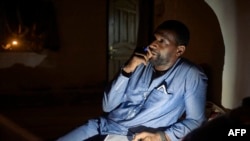Four months ago Sunday, French freelance journalist Olivier Dubois was kidnapped in Mali.
Dubois, who regularly worked for outlets including the French daily Libération, had been trying to arrange an interview with the local leader of the al-Qaida affiliated group Jama’at Nusrat al-Islam. Instead, the group kidnapped him.
At first, details of his kidnapping were not made public. But in May, his captors released a video of Dubois calling on French authorities to help free him.
Dubois is one of 10 visual journalists featured by the One Free Press Coalition, a collective of media organizations that shines a light on journalists under threat. Others featured in August include Reuters photojournalist Danish Siddiqui, who was killed covering fighting between Afghan security forces and Taliban fighters; and camera operators who have been injured, assaulted or threatened while covering protests.
Their cases highlight the dangers for video journalists and photographers reporting from regions experiencing violence and instability, analysts say.
Twenty-five years ago, “people would wear a ‘press’ jacket and assume that that would afford you some sort of security – that if everybody knew you were press, they would avoid hurting you,” said Clothilde Redfern, director of the Rory Peck Trust, a London-based organization that supports freelance journalists. “If anything, now being press means there's a target on your back.”
Added to that, the nature of a photojournalist’s job means getting close to the action. “Their eyes are occupied. So literally, they can't watch their back. They're looking down the lens,” Redfern said.
Elisabet Cantenys, executive director of A Culture of Safety Alliance (ACOS), told VOA that photographers and video journalists face distinct risks in conflict zones.
Photojournalists can be more conspicuous because of bulky equipment, and sometimes cameras are mistaken for weapons, said Cantenys.
Her organization, ACOS, works with media organizations and freelancers to try to limit those dangers, including by providing advice on better approaches to safety and risk management.
Cost of safety
As global hostility toward journalists has worsened in recent years, freelance journalists have been disproportionately affected.
Freelancers face heightened danger because they often lack the institutional support that staff have access to, Cantenys said.
“They are not being looked after as they should,” Cantenys told VOA, saying that freelancers often fall between the cracks. “Even some of the news organizations that have safety protocols and have the best crisis management protocols – even those news organizations sometimes don't have a protocol for freelancers.”
ACOS recommends basic steps for outlets including hostile-environment and first-aid training; creating an emergency plan in case of kidnap or injury; and a full risk assessment for each assignment that includes weighing whether the dangers outweigh the story.
In Dubois’ case, the Paris-based newspaper Libération said it had turned down the journalist’s pitch because of the risk.
Libération did not respond to VOA’s request for interview.
As well as being on the frontline of action, freelancers often face economic constraints.
“The No. 1 risk for freelance journalists is financial precarity. Limited finances are linked to limited safety,” Redfern told VOA.
News outlets may pay freelancers minimally or late, and they rarely provide freelancers with expense budgets, Redfern said. As a result, freelancers tend to cut corners, for instance by taking cheaper but unsafe transportation.
In 2019, the journalist association Frontline Freelance Register surveyed more than 380 journalists who typically cover risky assignments. The survey found that 75% of respondents said financial limitations impacted their safety. Nearly 70% said they did not have insurance, often because it is too expensive.
News outlets cover these expenses for their staff journalists. In an ideal world, Redfern said the same support would be provided to freelancers.
Journalists are responsible for their risk assessment, but then they need to discuss with their editors whether the editorial value outweighs the risk, Redfern added. And if it does, they need to develop a safety plan unique to the assignment.
“No one thinks that any story is worth a dead journalist,” Redfern said.
For journalist Dubois, officials, colleagues and media watchdogs in France are working to keep his case in the spotlight.
His family this week called on the governments of France and Mali to work together to achieve his release.
And a banner that reads, “Olivier is fighting to inform us, let’s not forget him,” has been put up outside a local administrative office in Paris.
“To campaign for Olivier’s release is to fight for the right to news and information,” Pierre Haski, president of media watchdog Reporters Without Borders, said in a statement.
“Without courageous journalists like Olivier, we would not know what is happening in (a region) where it is becoming increasingly difficult to work.”













